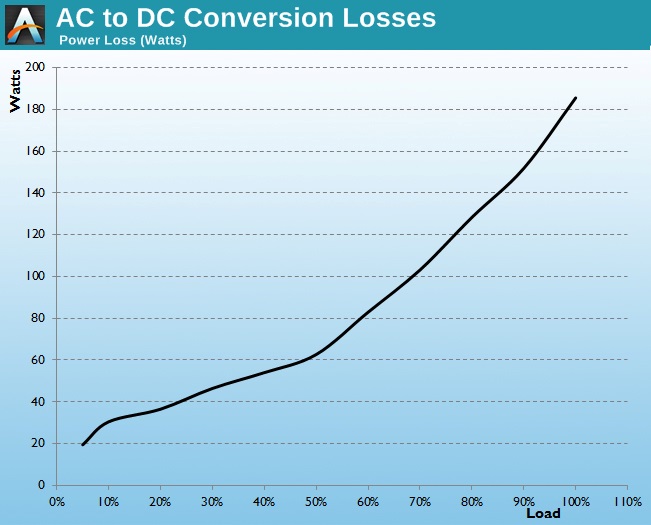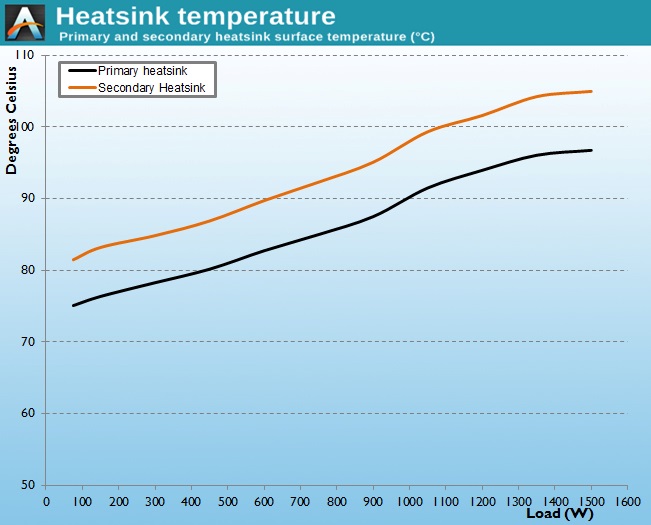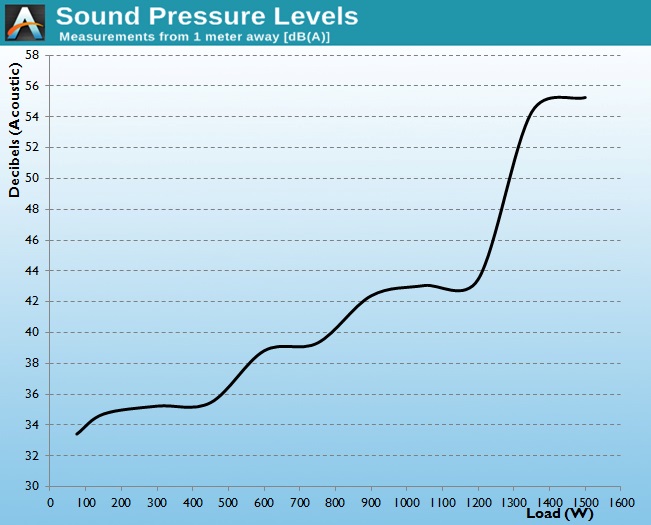The SilverStone Strider Gold S 1500W PSU Review
by E. Fylladitakis on April 7, 2015 8:00 AM EST- Posted in
- Cases/Cooling/PSUs
- PSUs
- SilverStone
- 1500W
Hot Test Results
As it can be seen in the following tables, SilverStone's currently most powerful PSU does offer outstanding power quality, especially if the massive power output is taken into account. The maximum voltage ripple on the 12V line is just 30mV at maximum load, under an outrageous current draw of nearly 110A. Ripple suppression is equally great on the minor voltage lines as well. Voltage regulation is a little more complicated, as the stability of the 12V line is amazing, with a change of less than 1% across the load range. However, the regulation of the 3.3V/5V lines is a lot less tight, at 2%/2.4% respectively.
| Main Output | ||||||||
| Load (Watts) | 303.02 W | 755.8 W | 1127.97 W | 1498.98 W | ||||
| Load (Percent) | 20.2% | 50.39% | 75.2% | 99.93% | ||||
| Line | Amperes | Volts | Amperes | Volts | Amperes | Volts | Amperes | Volts |
| 3.3 V | 4.55 | 3.39 | 11.38 | 3.38 | 17.07 | 3.34 | 22.76 | 3.33 |
| 5 V | 4.55 | 5.15 | 11.38 | 5.14 | 17.07 | 5.04 | 22.76 | 5.02 |
| 12 V | 21.85 | 12.09 | 54.63 | 12.06 | 81.94 | 12.02 | 109.26 | 11.98 |
| Voltage Ripple (mV) | |||||||
| Line | Regulation (20% to 100% load) |
||||||
| 20% Load |
50% Load |
75% Load |
100% Load |
CL1 12V |
CL2 3.3V + 5V |
||
| 3.3V | 2% | 6 | 8 | 14 | 20 | 10 | 26 |
| 5V | 2.4% | 6 | 10 | 16 | 24 | 10 | 30 |
| 12V | 0.9% | 8 | 16 | 22 | 30 | 34 | 16 |
Once again, we need to mention that this is a PSU rated at 40°C and we perform our testing at temperatures higher than 45°C - we could reduce the ambient temperature of our hotbox testing but we chose not to do so as the results would then not be comparable to those of our previous reviews.
According to these results, it becomes apparent that SilverStone is most likely just playing it safe regarding the 40°C rating for continuous operation. High ambient temperatures had little effect on the performance of the ST1500-GS, reducing its energy conversion efficiency by an average of just 0.3%. The maximum efficiency is reduced to 91.6% at exactly half load.
High temperatures are to be expected from a PSU with this kind of power output and the ST1500-GS does get terribly warm when fully loaded under these conditions. Do note however that the probe that is taking our secondary side readings is now sandwiched between the thermal pad and the chassis (that acts as the main secondary side heatsink), meaning that the readings are naturally higher than with other models. The cooling fan once again follows a "stepping" speed model - the only difference is that now the fan jumps up to maximum RPM at 90% load, correctly abandoning every notion of acoustic comfort to ensure reliability.















32 Comments
View All Comments
malkolm - Tuesday, April 7, 2015 - link
Maybe i missed it, but what about security features like OCP and so on?From the "power specifications" on page 1 i would asume the PSU to be a multi-rail device, of course. But is it truly a two-rail design or is it split even more?
DanNeely - Tuesday, April 7, 2015 - link
I'm curious why your full load test pulled so much current on the 3.3/5V rails. You've got them both over 90% individually; but only have the 12v rail at 78% load. Any realistic load near the full output would be skewed much more heavily toward maxing out 12V. On the mobo, USB ports are the only significant user of +5V; and I don't think there're any major users of 3.3V at all. (PCIe cards are allowed to draw upto 10W of it; but AFAIK the only ones that did were transitional models that combined an existing legacy-PCI design with a bridge chip.)More troubling is that you're drawing a total of 193W of 3.3/5V power but the PSU is only rated to give 150W combined on those rails. While it obviously didn't cause anything to fail or go out of spec; but going nearly 30% out of spec is troubling. The only justification for doing so deliberately that I can think of is if your tester couldn't go above 110A on the 12V rail; although in that case I think it should've been called out explicitly in the article.
E.Fyll - Thursday, April 16, 2015 - link
Actually, I have a much better justification for that.The only official testing procedures that exist, which are given in the methodology article, result to these minimum loads. If you had checked this article, you would see that my tester can go up to 240A on the 12V alone anyway.
I cannot lower the load to the 3.3V/5V buses without inventing my own testing methodology, in which case I would be rendering all comparisons between reviews useless and misleading. This is a general problem with very high output PSUs, the specifications go down the drain and fail to meet even basic certification standards, all in the name of massive power output. Perhaps I will consider "circumventing" this issue in my future reviews by forcing a divider once the load exceeds 1000W.
Pissedoffyouth - Tuesday, April 7, 2015 - link
Is there any hardware which could even use this amount of power?Let's say some OC'd 8 core Intel i7 or dual CPU 18 core xeons, 4x crossfired 7990s under full mining load with a 8 drive raid 5 15k RPM SAS setup, let's add some hardcore water cooling and every device in the house charging off USB.
Would this even push a kilowatt?
MobiusPizza - Tuesday, April 7, 2015 - link
The only case you are even anywhere close to using >1kW is with quad SLI/Crossfire and top end GPUs.DanNeely - Tuesday, April 7, 2015 - link
Even without overclocking even a 3 GPU system could exceed 1kw. There've been cards with rated TDPs of at least 300W; IIRC seeing 375 for something but that might've been a 3rd party dual GPU card not an official design since IIRC the PCIe spec tops at 300W.4x300W cards is 1200W, add an overclocked CPU fast ram and all the other odds and ends in a case and you could hit >1400W easily enough. (According to CPUz, my 4790k hit 145-150W at 4.7ghz with 32gb of DDR3-2400 ram under some prime95 FMA stress testing loads.)
3DVagabond - Saturday, April 11, 2015 - link
Try and get a quad sli/crossfire setup to load all 4 gpu's 100%. Not going to happen.hammer256 - Tuesday, April 7, 2015 - link
4x GTX690, a -E platform, and lots of fans would do the trick ;) Not for gaming though.hammer256 - Tuesday, April 7, 2015 - link
The PSU used for that system is a LEPA G1600, a bit cheaper than this one.rtho782 - Wednesday, April 8, 2015 - link
You can't crossfire 4 7990s, as they are dual chip already, so 2 7990s is quad crossfire, and would use less power than 4 7970s.I used to have an overclocked i7 920 (130W TDP, pushed to 4GHz so probably ~180W), 12GB ram, a few hard drives, 7970+7990 trifire, and absolute max I'd use (corsair link on an AX1500i) was ~880W.
Now, with 4970k and 980SLi, I struggle to hit ~475W.